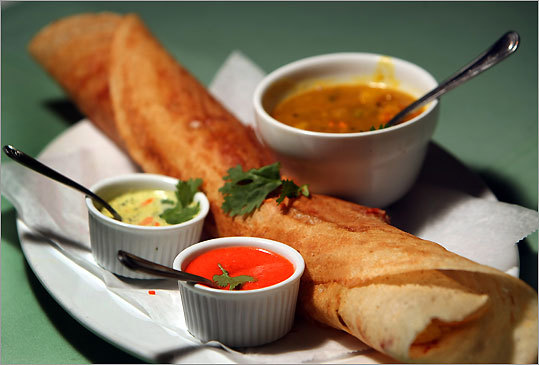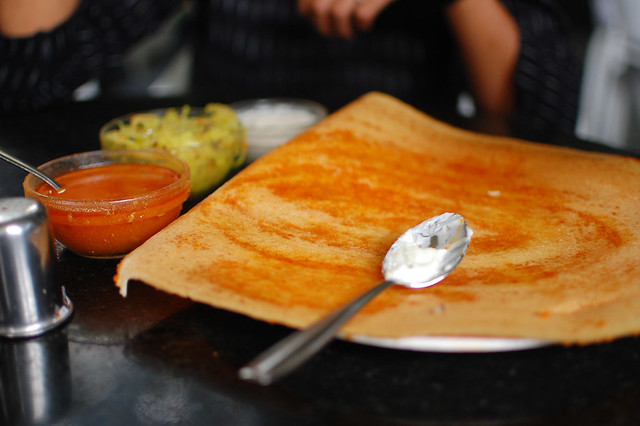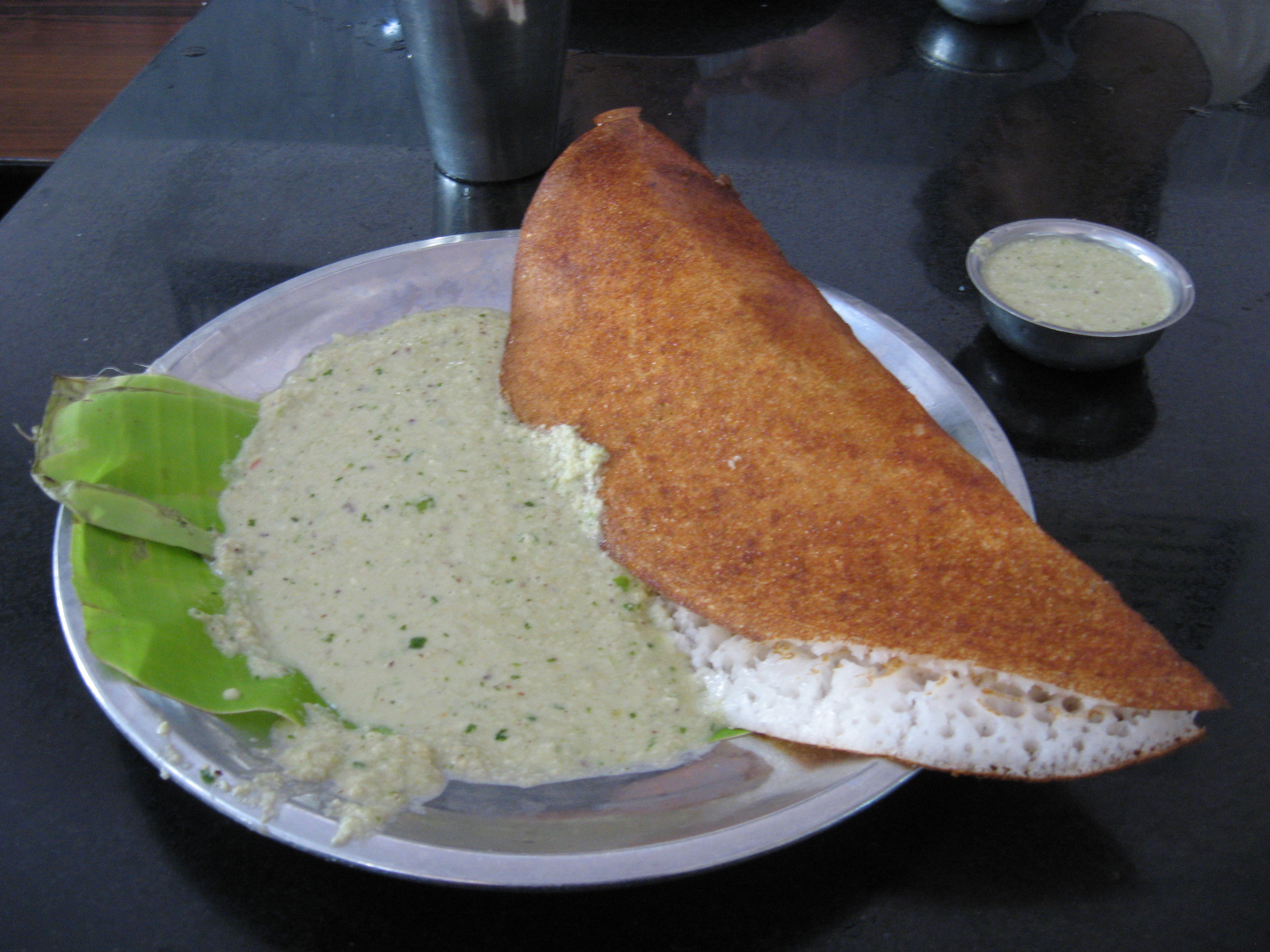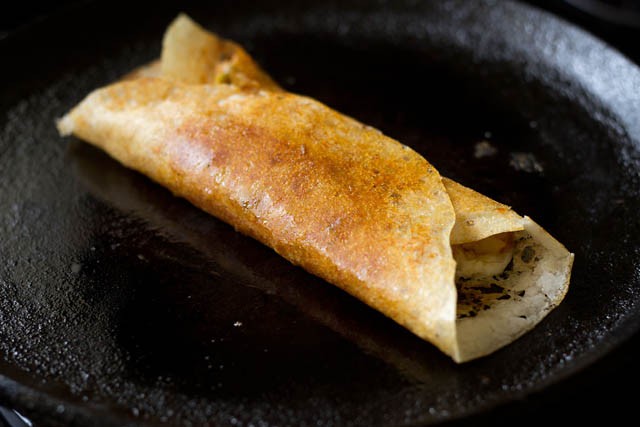South Indian Food Recipe Mysore Masala Dosa Biography
Source(google.com.pk)
Dosa is a signature dish of South India, where it’s a common breakfast item. Dosa is a delicate rice and lentil crepe made with a naturally fermented batter that is most commonly served as ‘Mysore Masala Dosa’ filled with coconut chutney and potatoes that are cooked with onion, turmeric, and spices. While under debate, dosa is thought to have originated in either Karnataka or Tamil Nadu. Today, it’s a main dish in all four South Indian states of Andhra Pradesh, Karnataka, Kerala and Tamil Nadu, as well as in Sri Lanka, Singapore, Malaysia, and Myanmar. This recipe is the one my mother made at home in Karnataka when I was growing up, and which I continue to make today.
Map of South India
South India comprises 4 states and 2 union territories, and occupies almost 20% of India’s area (Source: Wikipedia)
Map of South India
Map of South India: Karnataka, Andhra Pradesh, Kerala, Tamil Nadu, Lakshadweep, and Pondicherry) (Source: Maps of India)
What does dosa taste like exactly? As described, it’s a thin, crisp crepe or pancake. It has a slight tangy taste due to the fermentation, and is savory rather than sweet. Without the filling, on its own it’s called ‘plain dosa’ that can be eaten with a variety of vegetable curries. The accompaniments vary from state to state. In North America, dosa is most often served with ‘sambar’ in restaurants, which is a soup-like dish made with lentils (toor daal), vegetables, onions, tomatoes, and South Indian spices like black mustard seeds and kari patha (curry leaves). Dosa fillings have evolved from the traditional coconut chutney and potato filling to include paneer, vegetables, chicken, spinach, mushrooms, you name it. The fillings enhance the “dosa experience” and depend on personal preference. It can be made crispy, soft, thin, or super thin (also known as ‘paper dosa’), and basted with oil or butter — less of it or lots of it! It is said that ordering a dosa in a restaurant is similar to ordering coffee at Starbucks because the combinations are endless. Dosa can be made the size of a dinner plate or it can be up to 5 feet long — which in some restaurants, can be the length of an entire table!
A 3-foot long dosa at Shree Krishna Chhaya
A 3-foot long dosa at Shree Krishna Chhaya restaurant in Mumbai
While the main ingredients in a classic dosa batter are fermented lentils and rice, variations include different grains instead of rice like the flour of buckwheat (raagi dosa), whole wheat flour, thin cream of wheat (also called rava dosa). There are dosas made with onions, cilantro, grated carrots, and chopped tomato mixed directly into the batter (this dish is called ‘uttappa’ that is thick and soft, and sometimes referred to as Indian pizza). Dosa is also made with variety of dals and very little rice, which does not require fermentation and called ‘adai,’ most common in Tamil Nadu. Every family has their own dosa recipe, much like how every Italian family has their own marinara sauce recipe. I hope you enjoy my homemade recipe passed down from my mother...........
Mysore Masala Dosa: South India's Signature Dish
Homemade ‘Mysore Masala Dosa’ with coconut chutney and potatoes: South India’s signature dish
Mysore Masala Dosa
Serves 6
Ingredients
For the rice portion of batter
2 cups rice (I generally use long grain rice (not basmati rice) — either a Thai rice called Maligrosa or a South Indian rice called Sona Masuri)
1 teaspoon fenugreek seeds
For the dal portion of batter
½ cup urad dal
1 tablespoon toor dal
1 tablespoon channa dal
For putting the batter together
1/2 teaspoon salt
Preparation
Wash rice and dals separately, only once each. In one medium bowl, combine rice and fenugreek seeds and add enough water to cover. In a second medium bowl combine dals and add enough water to cover. Soak both bowls for 6 hours or overnight.
First grind the rice-fenugreek seed mixture and soaking water in a blender — it’s important to use the water it’s been soaked in, which helps the fermentation process. Do the same for the dals. The urad dal should be ground very fine, along with the water that it’s soaked in. It will look little light and fluffy when ground.
Now put it all together — in a large glass bowl, combine all the ground mixtures (rice-fenugreek-soaking water mixture AND daal-water mixture). Mix well, add ½ teaspoon salt and pour into a container and keep in the over or in a warm place overnight. Do not add extra water, as the batter is quite thick at this point. Cover the container with a lid tightly, with a slight opening. Then, cover the container with a large towel to keep it warm. In hot summer days, a towel is not necessary. The fermentation takes place when the urad dal and rice are combined — this is a natural fermentation process (no yeast, baking powder, or baking soda are used).
The batter will be ready the next morning. It should not be too thick (it should be thinner than pancake batter). If you need to, add a little amount of water to get the right consistency.
Ingredients for dosa batter: rice, fenugreek seeds, and dal
The main ingredients in a classic dosa batter: rice, fenugreek seeds, and dal
Soaking dal for dosa mix
Soak dals together
Soaking rice and fenugreek seeds together for dosa mix
Soak rice and fenugreek seeds together
Dosa batter blended
Blend the rice-fenugreek mixture in the soaking water & then the dal mixture in the soaking water; then combine to create dosa batter
Storing dosa batter in air-tight container overnight
Combine both ground mixtures and store in air-tight glass bowl overnight to allow to ferment (oven is off)
Ingredients for Potato Palya
4 large potatoes
3 onions sliced
1-2 tablespoons canola oil
1/2 teaspoon black mustard seeds
5-7 kari patha leaves
1/8 teaspoon asafoteda (also known as ‘hing’)
1/2 teaspoon urad dal
1/2 teaspoon channa dal
1/8 cup finely chopped fresh green chillies
1/2 teaspoon turmeric
1 teaspoon salt
1 teaspoon fresh lemon juice
1/4 cup fresh cilantro, finely chopped
Preparation
Peel and boil potatoes till they are cooked. Drain and mash them slightly.
Heat oil on medium heat and add mustard seeds. When they begin popping, add urad dal and channa dal, karipatha, hing, green chillies and sauté for 1 minute. Keep the heat low at this point as it can brown quickly. Add sliced onions, mix well, turmeric, and salt. Saute until the onions are soft, then add the cooked potatoes. Mix well on low heat, to combine the flavours. When completely mixed and heated through, taste for the seasonings. Adjust if necessary. Add fresh lemon juice and chopped cilantro and mix well. Turn off the heat.
Boiling potatoes for playa with masala dosa
Boil 3 potatoes and mash them
Adding fresh lemon juice to potato playa with masala dosa
Finishing touches include adding turmeric, fresh cilantro, and fresh lemon juice
Potato palya (masala potatoes) ready to be stuffed into a dosa
Potatoes are all ready to be stuffed into a dosa!
Ingredients for Coconut Chutney
2 cups chopped fresh OR frozen coconut (if neither fresh nor frozen are available, you can use dry unsweetened coconut).
½ cup fried channa dal (also known as ‘hurigadale’)
1/2 cup water
2 fresh green chillies
½ teaspoon salt
1 teaspoon lemon juice OR tamarind juice
½ teaspoon brown sugar
½ cup chopped fresh cilantro
For tempering
2 teaspoons canola oil
1/4 teaspoon black mustard seeds
4-5 kari patha leaves
Preparation
In a blender, grind the coconut and fried channa with water till coarsely ground, not completely ground.
Add the remaining ingredients except cilantro and grind to a finer consistency.
Finally add cilantro and blend lightly so that everything is mixed well and green specks of cilantro are visible.
Taste and adjust seasonings. Pour into a serving bowl.
For tempering: heat teaspoons canola oil in a small saucepan, add ¼ tsp mustard seeds, whey they pop, add karipatha and turn the heat off. Add this oil mixture to the chutney and mix well.
Fresh coconut pieces
Fresh coconut pieces
Adding tamarind juice for coconut chutney
Add a teaspoon of tamarind juice; if you don’t have it, use lemon juice
Grinding raw coconut pieces together with dale, green chilli, tamarind juice and brown sugar
Grind the coconut together with dals, green chilli, tamarind juice, and brown sugar
Ground coconut chutney
Grind it until it looks like this
Adding tempering mixture to finish coconut chutney
Add the tempering mixture to finish the coconut chutney
Making the Mysore Masala Dosa…it’s all in the wrist!
Medium-sized cast iron OR non-stick pan with matching lid
Canola oil OR ghee (clarified butter)
Paper towels
Clean kitchen cloth
Spatula
Preparation
Heat a cast iron pan (or non-stick pan if you don’t have cast iron)
Spread small amount of oil on the pan with a cloth to coat well.
When the pan is hot, pour 1/2 cup of the batter into the middle with a ladle. With the back of the spoon, spread the batter quickly in clockwise direction (see photo below). Pour 1/2 tsp of oil or ghee (clarified butter) on it, cover and let it cook. It will take about 2 minutes. When the edges look brown and crispy, turn the dosa with a spatula and cook on the other side for 30 seconds. Turn the dosa over again with a spatula. Now spread it with a layer of coconut chutney and place a tablespoon of the masala potatoes in the middle. Fold the dosa in half and gently brown it on both sides until it’s golden brown. Finish with a touch more oil or ghee.
Repeat the process for the other dosas.
Tip : As the pan gets heated, it goes quite fast. You may have to adjust the heat as you go along.
Coating a cast iron pan with oil for masala dosa
Coat a cast iron pan generously with oil before heating
Making dosa on a cast iron pan
Pour 1/2 cup of the dosa mixture into the center of pan and spread in clockwise direction quickly
Making dosa on a cast iron pan
Once the edges start to brown, flip it!
Spreading coconut chutney on dosa
Add a generous spoonful of the coconut chutney and spread evenly as the first layer of the dosa stuffing
Adding potatoes to masala dosa with coconut chutney
Follow the coconut chutney with a generous heap of the masala potatoes
Folding dosa in half sealing in coconut chutney and masala potatoes
Using your spatula, carefully fold the dosa in half, sealing in the coconut chutney and masala potatoes
Gently pressing down on masala dosa with spatula
Gently press down with a spatula to seal it tight
Finishing masala dosa with touch of oil or ghee
Finish with a touch more oil or ghee (clarified butter) before serving..........
South Indian Food Recipe Mysore Masala Dosa

South Indian Food Recipe Mysore Masala Dosa

South Indian Food Recipe Mysore Masala Dosa

South Indian Food Recipe Mysore Masala Dosa
South Indian Food Recipe Mysore Masala Dosa

South Indian Food Recipe Mysore Masala Dosa

South Indian Food Recipe Mysore Masala Dosa

South Indian Food Recipe Mysore Masala Dosa

South Indian Food Recipe Mysore Masala Dosa

South Indian Food Recipe Mysore Masala Dosa

South Indian Food Recipe Mysore Masala Dosa

South Indian Food Recipe Mysore Masala Dosa

South Indian Food Recipe Mysore Masala Dosa

South Indian Food Recipe Mysore Masala Dosa

No comments:
Post a Comment